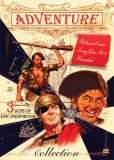| Reviews & Columns |
|
Reviews DVD TV on DVD Blu-ray 4K UHD International DVDs In Theaters Reviews by Studio Video Games Features Collector Series DVDs Easter Egg Database Interviews DVD Talk Radio Feature Articles Columns Anime Talk DVD Savant Horror DVDs The M.O.D. Squad Art House HD Talk Silent DVD
|
DVD Talk Forum |
|
|
| Resources |
|
DVD Price Search Customer Service #'s RCE Info Links |
|
Columns
|
|
|
Epic Adventures Collection: Robinson Crusoe (1952), Long John Silver & Hannibal (1959)
VCI Entertainment has released a curious selection of three vintage adventure films and titled the box set, Epic Adventures Collection. Featuring Luis Bunuel's Robinson Crusoe, Byron Haskin's Long John Silver, and Edgar G. Ulmer's Hannibal, each of these three have already appeared on DVD, so there's no need to double-dip if you already own them. While the directors listed above would seem to suggest that the Epic Adventures Collection was worth your time, only one title is really successful, with the remaining two marginal trifles at best.
ROBINSON CRUSOE
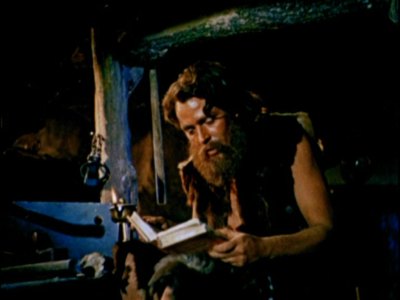
Certainly the best known and most successful of the three offerings in the Epic Adventures Collection, Luis Bunuel's Robinson Crusoe finally comes to DVD in what is likely the best available transfer we're to get in the foreseeable future. Starring Irish actor Dan O'Herlihy (who snagged an Oscar nomination for this role, in his otherwise underutilized screen career), Robinson Crusoe is a smartly drawn adaptation of the Daniel Defoe classic, affording viewers who know nothing of its director's predilections a straightforward, successful adventure yarn, while those in the know will enjoy brief flashes of Bunuel's surrealistic obsessions.
Shot on location in Mexico, Robinson Crusoe tells the familiar fictional story of wealthy slave trader Crusoe, who, in 1659, finds himself marooned on a deserted tropical island. Able to gather some essential foodstuffs and materiel from his scuttled ship, Robinson makes it to shore and sets about learning how to survive in his prison paradise. Years and years of utter loneliness and despair follow, until Robinson rescues an intended victim of a cannibal raid, and keeps him for himself. Named Friday, the "savage" is soon tamed by Crusoe - through the use of leg irons - until Robinson has a change of heart, and welcomes Friday as his friend and companion. But will the two be able to leave their island, when pirates set ashore?
For years I've heard about Bunuel's version of this oft-filmed story, but for all I knew, it was a lost work; I've never seen it available on TV or revival houses, and I don't remember seeing it on video. Viewed today, it's apparent that Robinson Crusoe is a "work for hire" assignment - Bunuel's first in English and in color - that still manages to slip in dream-like flashes of the perverse, bizarre Bunuelian humor that attacks (or here, obliquely criticizes) organized religion and bourgeois values. While most of Robinson Crusoe can be viewed as a relatively straightforward rendition of the novel (and a moving, exciting one, at that), with dramatic and action scenes essentially indistinguishable from any Hollywood studio director, Bunuel, either out of boredom or a playfulness to see what he could work in a mainstream adventure picture, slips in little jolts of surrealism and mocking cynicism that definitely brand Robinson Crusoe as something outside mainstream Hollywood filmmaking.
Probably the most overt "Bunuelian" sequence is the famed fever dream that Robinson experiences in his fortified little cave. Sick and delirious with fever, a parched Robinson calls out for water to his hallucinated father, who sternly rebukes Robinson's folly for shipping out - all the while pouring clean, cool water over a hog he's washing! Continuing his condemnation of Robinson, his father is pictured floating, Messiah-like, in water, until some unknown person or force pulls him under. Robinson himself is shown, also in a Christ-like pose, bound to a crucifix, unable to bend down to drink the abundant water swirling around him. Bunuel, the master of absurdist surrealism, of course offers no explanations for these images, leaving it up to you to ponder their meaning (if indeed there is any meaning to them; Bunuel frequently declined to give any credence to theories about his films). Other smaller Bunuelian flourishes pop up, including Robinson looking longingly at a scarecrow he's adorned with a woman's dress (while reacting vaguely sick at the site of Friday in a similar dress); Robinson calling out Bible passages to his own "valley of echoes," bringing him absolutely no solace in his loneliness; feeding an innocent ant to a predator strictly for sport; and Robinson uncomprehendingly dismissing Friday's perfect logic in rejecting Crusoe's fundamentalist views on the necessity of the existence of the devil to offer man temptation away from God. My favorite is a little throw-away bit where Robinson, who after burying his loyal, faithful dog Rex, returns heartsick to his cave only to hear his parrot mockingly screech, "Here, Rex! Here, Rex!" It's a sick joke, entirely in keeping with Bunuel's sense of humor, and obviously injected by the director to enliven the otherwise straight story.
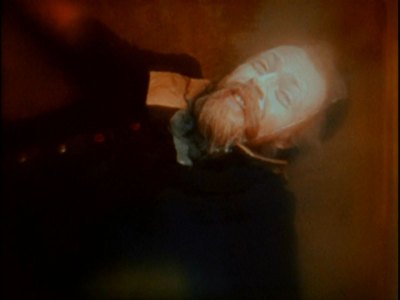
The DVD:
The Video:
The full screen, 1.33:1 video transfer for Robinson Crusoe is probably as good as we're going to get, considering that the original elements are in no man's land, apparently. An acceptable but by no means perfect release print was digitally cleaned up, but it wasn't a very thorough job. Color shifts wildly at times, and there are gate problems (probably due to shrinkage) throughout. Splices and specks still show, and there's a certain softness to the image. Still, this is your only shot so far to see this classic.
The Audio:
The Dolby Digital English soundtrack is in big, fat mono, and it sounds fairly good, minus the few pops and hiss that are frequently apparent. There's also a Spanish language track available, with optional English subtitles.
The Extras:
There's a fascinating 50-minute audio interview with O'Herlihy where he discusses his career. Text bios are included, along with a photo gallery, a before-and-after restoration peek at the film, but the promised collectible pressbook reproduction wasn't included.
Final Thoughts:
A relatively straightforward adaptation of the Defoe classic, Bunuel's Robinson Crusoe still has a few glimpses of the surreal obsessions that Bunuel no doubt enjoyed throwing out there -- particularly in a "work-for-hire" job like this one.
LONG JOHN SILVER
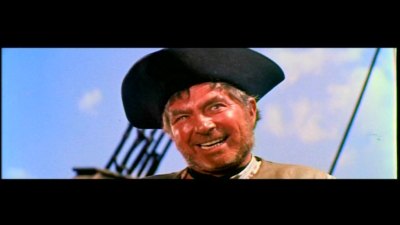
A rather inferior sequel to the exciting Disney classic, Treasure Island, Long John Silver reunites director and star from that bona fide adventure classic, but manages little of the charm and verve of the original. Robert Newton is a hoot, as always, and the production design does have an agreeably cartoonish, comic-book look to its garish coloring, but a protracted length and a dearth of action sink this would-be pirate epic.
The story, such as it is, concerns ribald, drunken pirate Long John Silver's (Robert Newton) attempts to find further gold on the famed Treasure Island. Possessing a map that claims to identify almost a million pounds more of Captain Flint's ill-gotten booty (or as M*A*S*H's Hawkeye said, "Ill-booten gotty"), Silver still needs a medallion keystone that positively locates the treasure - a medallion that Jim Hawkins (Kit Taylor) now wears. Saving the Governor Sir Henry Strong's (Harvey Adams) daughter from kidnaping pirate Captain "El Toro" Mendoza (Lloyd Berrell), Silver helps himself to the Governor's warehouse of treasure, and schemes to follow Jim (who was also kidnapped by Mendoza), who is being sent back to England. Freeing Jim, Silver's plan to return to Treasure Island is seriously compromised by Mendoza, who beats him there, while Jim has to elude the blind Patch (Rod Taylor), who swears vengeance on the boy who caused his affliction.
There's nothing really to hate about Long John Silver, but there's nothing really to celebrate about it, either. It's always a pleasure to see the transcendentally hammy Newton revisit his most famous role. Squinting that one eye, and rolling the other up to the heavens, Newton manages an "Aaarrrr!" about every other sentence, and it never gets old hearing it. He's tremendously funny when, after taking a drink from his nightmarishly shrewish "fiancé" Purity Pinker (Connie Gilchrist), he spats it out, exclaiming, "Milk! I be poisoned!". Stumping along on his peg leg, and double-and-triple-crossing everyone in sight, while spouting flowery imprecations of dire consequences, Newton is frequently down-right hilarious.
But alas (or "avast"), an essentially one-note performance, no matter how good or enjoyable, can't carry this poky pirate film. Too many opportunities for genuine suspense and action pop up, only to be talked to death; there's far too much exposition for a supposedly jaunty romp, not helped, either, by the almost two-hour running time. Central to the whole Stevenson tale was the rather terrifying (from a youngster's viewpoint) love/hate relationship between Hawkins and Silver. Was Silver truly heartless, or did he care for Jim in his own way? The first Disney film adequately recreated this dynamic, in no small part because of the expressive, gifted performance by that amazing child actor, Bobby Driscoll. Kit Taylor, although fine as this new Hawkins, either can't work up the same emotional chemistry with Newton, or, more likely, he wasn't given any chance to, considering the stilted dramatics of the piece. We just never feel that conflicted bond between Silver and Jim that would make the whole thing work. And without it, Long John Silver is a fairly empty affair.
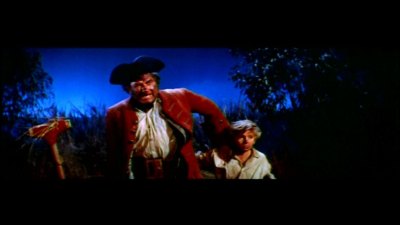
The DVD:
The Video:
Long shown in only hideous pan-and-scan, public domain copies, Long John Silver now comes to DVD in a relatively sharp little transfer, that approximates the original 2.55:1 CinemaScope ratio. Anamorphically enhanced, there's still some squatty lumpiness to the image (which may stem from a transfer from a matted source material), but overall, the agreeably garish color scheme (with occasional nasty color shifts) does resemble a "Classics Illustrated" book comic book come to life.
The Audio:
The Dolby Digital English 5.1 stereo mix is surprisingly effective, with a bit of alright oomph in the action scenes. Directionality is fairly well balanced. There are no subtitles.
The Extras:
The only extras are original theatrical and TV trailers, bios for some of the cast, a before-and-after restoration peek at the film, and some other VCI trailers.
Final Thoughts:
Cartoonish in production design and lensing, Long John Silver does have Robert Newton chewing on anything that isn't nailed down while he hams it up again as the notorious pirate, but that's about it in this overlong, sparsely-actioned pirate film.
HANNIBAL
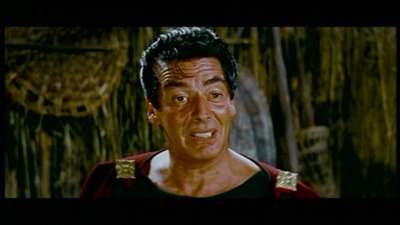
One of the final signposts in action icon Victor Mature's primary career phase, 1959's Hannibal might seem like a natural film for rediscovery, considering the cult that has risen up around its director, Edgar G. Ulmer. And I suppose there are Ulmer fanatics out there who have poured over it, finding Ulmerian references and stylistic similarities in this Italian sword and sandal would-be epic. Unfortunately, from Ulmer's own words, Hannibal comes off as mere spectacle, and not an especially compelling spectacle, at that.
Chronicling Hannibal's (Victor Mature) incredible 15-day trek across the Alps to take on Rome, Hannibal features Gabriele Ferzetti as Senator Fabius Maximus, the lone voice in the Roman Senate who views Hannibal's coming assault as a do-or-die moment in history that Rome tragically misjudges. Infinitely complicating matters is the fact that Maximus' niece, Sylvia (Rita Gam), who has been captured by Hannibal (along with Fabius' son Quintilius, played by a young Terence Hill), has fallen in love with the Carthaginian conqueror. Numerous (and protracted) court intrigues follow, with Hannibal moving closer and closer to his goal of wiping out Rome, while Maximus, who walked away from the Senate when his words of caution weren't heeded, reassumes power against Hannibal, while learning of the treachery of his beloved niece.
Not unlike Long John Silver, too much talk spoils Hannibal, although when the action comes, it's not badly delivered, considering the budget limitations. Scenes of romantic and political machinations dominate the film, and it's intriguing to guess where Ulmer would have went with the film, had Warner Bros. allowed his version of the script to be filmed. According to a fun audio interview with Peter Bogdanovich, included on this DVD, Ulmer planed Hannibal as an examination of a man outside of his culture, viewing the coming future with dread as he realizes his own way of life has passed. That theme fits with some of the isolated scenes of betrayal and existential, romantic longing that infrequently pop up in Hannibal, but according to Ulmer, most of this was thrown out in favor of action spectacle. Certainly the highlight of the film is Hannibal's march over the Alps, and some of the set pieces (soldiers getting crushed by elephants: soldiers getting their faces eaten off by wolves; soldiers/obvious dummies falling to their deaths) probably seemed cool to us kids back in the early seventies, when this kind of acceptable "gore" was routinely shown on late, late shows. Today, though, it's quite tame, and it's hard not to notice how all the elephant scenes, and quite a few of the combat scenes are shot on dinky, small studio sets (no doubt due to not being able to take the elephants on location), that don't mix very well with the location shots.
Mature, one of my all-time favorites, at least has the good sense to notch down his florid delivery not a inch. Watching Mature, in all his campy glory, toss aside his helmet with a flourish that would make Bette Davis blush, is to know the true meaning of "ham." Mature, a most accomplished, sensitive actor in his early career, had by this point in his life given himself over to thoroughly conventional kinds of action films, muting the disappointment of the scripts with a stock enthusiasm that plays campy today. By the time that Hannibal rolled around, Mature had traded in on his muscular good looks and his put-on, outsized emoting far too many times, with efforts like One Million B.C., Samson and Delilah, Androcles and the Lion, The Robe, The Veils of Bagdad, Demetrius and the Gladiators, The Egyptian, Zarak, and The Bandit of Zhobe thoroughly typecasting him into empty-calorie, would-be epics. It's to Mature's great credit and personality that despite these lesser efforts, audiences were still fond of the actor, whose good-natured self-parody of his on-screen persona in Vittorio De Sica's After the Fox won universal raves. Unfortunately, he had to wade through dreck like Hannibal first, to find that renewed acceptance of his prodigious talents.
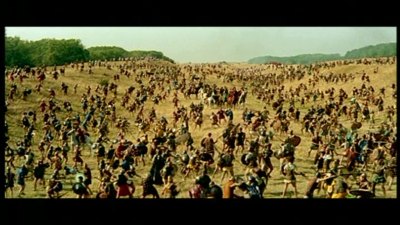
The DVD:
The Video:
The anamorphically enhanced, 2.35:1 widescreen transfer for Hannibal looks quite good here, with some rich color (and accompanying grain) and a relatively sharp picture.
The Audio:
Unfortunately, the Dolby Digital audio track is in the original mono; I purely would have liked to hear those falling soldiers scream in 5.1.
The Extras:
Besides the aforementioned audio interview with Ulmer (that runs a healthy 32 minutes), there's an original theatrical trailer, a poster and picture gallery, and some text bios of the stars and director.
Final Thoughts:
Victor Mature, regardless of the (low) level of his later efforts, is always a joy to watch, just for his carefree, totally un-self-conscious emoting. And some of the battle scenes in Hannibal have a nostalgic, naive appeal that older viewers might welcome. But anyone looking for a cult item to add to director Edgar G. Ulmer's canon might scratch their heads searching for anything of substance. Certainly watchable, but a thorough miss considering what it could have been.
Final Thoughts on the Boxed Set:
Looking back over the films included in VCI's Epic Adventures Collection, I want to give it a higher rating than a rental, particularly since Bunuel's entertaining Robinson Crusoe is featured. But all of these films have already been released, and no new extras have been commissioned. And let's face it: Long John Silver and Hannibal are failed films, at best. A rental should do for completists, but all others can skip the Epic Adventures Collection.Paul Mavis is an internationally published film and television historian, a member of the Online Film Critics Society, and the author of The Espionage Filmography.


|
| Popular Reviews |
| Sponsored Links |
|
|
| Sponsored Links |
|
|
| Release List | Reviews | Shop | Newsletter | Forum | DVD Giveaways | Blu-Ray | Advertise |
|
Copyright 2024 DVDTalk.com All Rights Reserved. Legal Info, Privacy Policy, Terms of Use,
Manage Preferences,
Your Privacy Choices | |||||||









